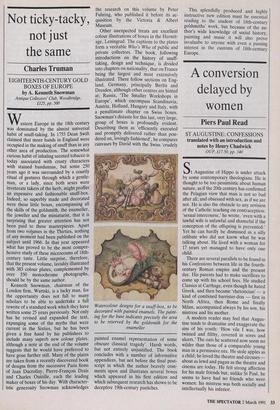Not ticky-tacky, not just the same
Charles Truman
EIGHTEENTH-CENTURY GOLD BOXES OF EUROPE by A. Kenneth Snowman
Antique Collectors' Club, Woodbridge, f125, pp. 500
Western Europe in the 18th century was dominated by the almost universal habit of snuff-taking. In 1755 Dean Swift claimed that more hands in England were occupied in the making of snuff than in any other area of production. The somewhat curious habit of inhaling scented tobacco is today associated with crusty characters with stained bandannas, but some 250 years ago it was surrounded by a courtly ritual of gestures through which a gentle- man, or a lady, since both sexes were inveterate takers of the herb, might proffer an expensive and fashionable snuff-box. Indeed, so superbly made and decorated were these little boxes, encompassing all the skills of the goldsmith, the enameller, the jeweller and the miniaturist, that it is surprising that greater attention has not been paid to these masterpieces. Apart from two volumes in the Thirties, nothing of any moment had been published on the subject until 1966. In that year appeared what has proved to be the most compre- hensive study of these microcosms of 18th- century taste. Little surprise, therefore, that the present volume, lavishly illustrated with 383 colour plates, complemented by over 550 monochrome photographs, should be by the same author. Kenneth Snowman, chairman of the London firm, Wartski, is a lucky man, for the opportunity does not fall to many scholars to be able to undertake a full rewrite of a standard work which they have written some 25 years previously. Not only has he revised and expanded the text, expunging some of the myths that were current in the Sixties, but he has been given a free hand by his publishers to include many superb new colour plates, although a note at the end of the volume suggests that he would have preferred to have gone further still. Many of the plates are taken from a recently discovered book of designs from the successive Paris firms of Jean Ducrollay, Pierre-Francois Drais and Charles Ouizille, each the leading maker of boxes of his day. With character- istic generosity Snowman acknowledges the research on this volume by Peter Fuhring, who published it before its ac- quisition by the Victoria & Albert Museum.
Other unexpected treats are excellent colour illustrations of boxes in the Hermit- age, Leningrad. The captions to the plates form a veritable Who's Who of public and private collectors. The book, following introductions on the history of snuff- taking, design and technique, is divided into chapters on nationality, that on France being the largest and most extensively illustrated. There follow sections on Eng- land, Germany, principally Berlin and Dresden, although other centres are hinted at; Russia, 'The Smaller Workshops in Europe', which encompass Scandinavia, Austria, Holland, Hungary and Italy, with a penultimate chapter on Swiss boxes. Snowman's distaste for this last, very large, group of boxes is profoundly evident. Describing them as 'efficiently executed and promptly delivered rather than pon- dered on, lovingly fashioned', he compares canvases by David with the Swiss 'crudely
Watercolour designs for a snuff-box, to be decorated with painted enamels. The paint- ing for the base indicates precisely the area to be reserved by the goldsmith for the enameller painted enamel representation of some obscure classical tragedy'. Harsh words, but not entirely unjustified. The book concludes with a number of informative appendices, but not before the final post- script in which the author bravely com- ments upon and illustrates several boxes which appeared in his first edition and which subsequent research has shown to be deceptive 19th-century pastiches. This splendidly produced and highly instructive new edition must be essential reading to the student of 18th-century goldsmiths' work, but because of the au- thor's wide knowledge of social history, painting and music it will also prove invaluabe to anyone with even a passing interest in the customs of 18th-century Europe.


















































 Previous page
Previous page